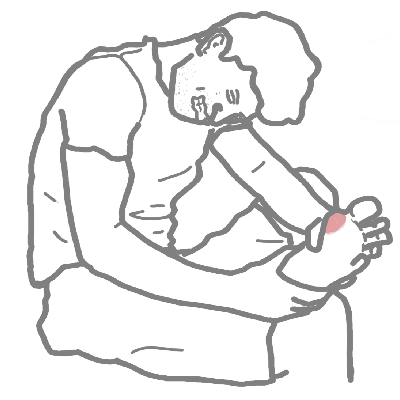Overview
Overview Gout is a common inflammatory arthritis that is increasing in prevalence. Gout (monosodium urate crystal deposition disease) is characterized biochemically by extracellular fluid urate saturation. Tends to occur earlier in life in men than women, and is rare in childhood. Prevalence is increasing. It is associated with many serious comorbidities such as hypertension, chronic kidney disease, obesity, diabetes and cardiovascular disease.
| Definition Gout: Defective metabolism of uric acid can build up in joints causing arthritis, especially in the smaller bones of the feet, deposition of chalk-stones, and episodes of acute pain. Pseudogout: Deposits of calcium pyrophosphate dihydrate crystals in the fluid and tissues of the joints, leading to intermittent attacks of arthritis |
Risk Factors
| Risk Factors |
| Older age |
| Male sex |
| Consumption of meat, seafood, alcohol |
| Menopausal status |
| Medications (Diuretics, cyclosporine/tacrolimus, pyrazinamide, aspirin) |
| Genetics |
| Haematological Malignancies (High cell turn over) |
| Chemotherapy (High cell turn over) |
| Diabetes |
Signs and Symptoms
Three classic stages in the natural history of progressive urate crystal deposition disease (gout):
- Acute gouty arthritis
- Intercritical (or interval) gout
- Chronic articular and tophaceous gout
| Remember Gout does not occur only in the great toe (podagra), although this is a common site for the initial episode. It can affect any joint in the body and can even mimic the polyarthritis of rheumatoid arthritis. |
1. Acute gouty arthritis
- Monoarthritic joint - 80% (usually big toe podagra or the knee)
- Severe pain, redness, warmth, swelling, and disability
- Polyarticular gouty arthritis is the initial manifestation in less than 20 percent of patients with gout, but occurs with increasing frequency in later flares.
2. Intercritical gout
- Intervals between attacks of acute gouty arthritis are of variable duration
- Tophi can already develop bony erosions causing chronic gout arthropathy
3. Chronic articular and tophaceous gout
- Polyarthritic joints
- Uric acid nephrolithiasis
- Tophaceous deposits - Tophi are typically not painful or tender
Differential Diagnosis
| Monoarthropathy | Oligoarthropathy | Polyarthropathy |
| Septic arthritis | Crystal arthritis | Rheumatoid arthritis |
| Crystal arthritis (Gout or Pseudogout) | Psoriatic arthritis | Viral Arthritis |
| Osteoarthritis (can be mono-poly) | Reactive arthritis | Autoimmune connective tissue disease (ie. SLE) |
| Trauma (Haemarthrosis) | Ankylosing spondylititis | Vasculitides (ie. Polymyalgia Rheumatica) |
Investigations
| Side note The chance of developing gout increases with increasing serum concentrations of uric acid. |
- Joint aspiration - synovial fluid analysis and view under polarized light
- Cell count
- Crystals
- Gram stain
- FBC
- EUC
- Urate levels
- ESR/CRP
- X-ray
- Soft-tissue swelling (acute gout)
- Asymmetry
- Punched out 'cyst' in the juxtaarticular bone
- Joint space narrowing
- Secondary osteoarthritis
- MRI
- Ultrasound
| Remember With any monoarthritic presentation, septic arthritis should be ruled out. This can be done with a Joint aspiration. |
| Synovial fluid analysis | |||
| Aetiology | Colour and Clarity | WBC (mm³) | |
| Normal | Normal | Clear and transparent | <200 |
| Non-Inflammatory | Osteoarthritis | Yellow and transparent | 0 to 2000 |
| Inflammatory | Gout | Yellow and traslucent-opaque | 2000-100,000 |
| Septic | Bacteria | Yellow/green and opaque | >25,000 - >100,000 |
| Haemorrhage | Trauma | Red and Bloody | 200-2000 |
Diagnosis For a definitive diagnosis of gout, urate crystals must be demonstrated in synovial fluid or in the tophus
- Synovial fluid should be analysed by polarised light microscopy
Aetiology
- There is a causal relationship between hyperuricaemia (high urate level) and gout.
- Factors that increase urate levels are potential causes
Pathophysiology
- Increase uric acid concentration in body causes deposition of uric acid crystals in joints
- Human lack enzymes capable of degrading uric acid
Management
Acute Attacks
- Colchicine
- NSAIDs - indomethacin
- Oral steroids such as prednisolone if multiple joints
- Steroid infection to joint if monoarthritis
Prophylaxis (preventing future attacks)
- Diet modification - less seafood
- Reduce alcohol intake
- Allopurinol
- Benzbromarone
Management plan
- Set urate target
- Start urate-lowering therapy with prophylaxis
- Ensure patient has acute flare plan
- Monitor serum urate until target reached
- Titrate urate-lowering therapy to achieve target
- Once target achieved, monitor 6–12 monthly
| Side note Allopurinol should not be stopped during acute flares of gout. Stopping allopurinol during an acute flare means therapeutic effect is lost and the urate level will rise. Historically, there has been concern that starting urate-lowering therapy such as allopurinol could worsen or prolong the acute gout flare, now this is not the case. |
| Pharmacology Allopurinol inhibits the enzyme xanthine oxidase, blocking the conversion of the oxypurines hypoxanthine and xanthine to uric acid. Side effects: arthralgia, joint stiffness or swelling and rash |
| Pharmacology Colchicine decreases leukocyte chemotaxis and phagocytosis and inhibits the formation and release of a chemotactic glycoprotein that is produced during phagocytosis of urate crystals. Colchicine has no analgesic or antihyperuricemic activity. Colchicine inhibits microtubule assembly in various cells, including leukocytes, probably by binding to and interfering with polymerization of the microtubule subunit tubulin. Side effects: nausea, vomiting, abdominal pain, and diarrhea (maybe bloody) occur first. Burning sensations of the throat, stomach, skin and muscular weakness can occur |
Complication and Prognosis
Complications
- Nephrolithiasis (kidney stones)
- Chronic urate nephropathy
Prognosis
- Acute gout attacks is painful and debilitating but self limiting
- Appropriate treatment can suppress gout attacks and their recurrence, and prevent long-term consequences of the disease
- Chronic articular and tophaceous gout may be associated with renal insufficiency













